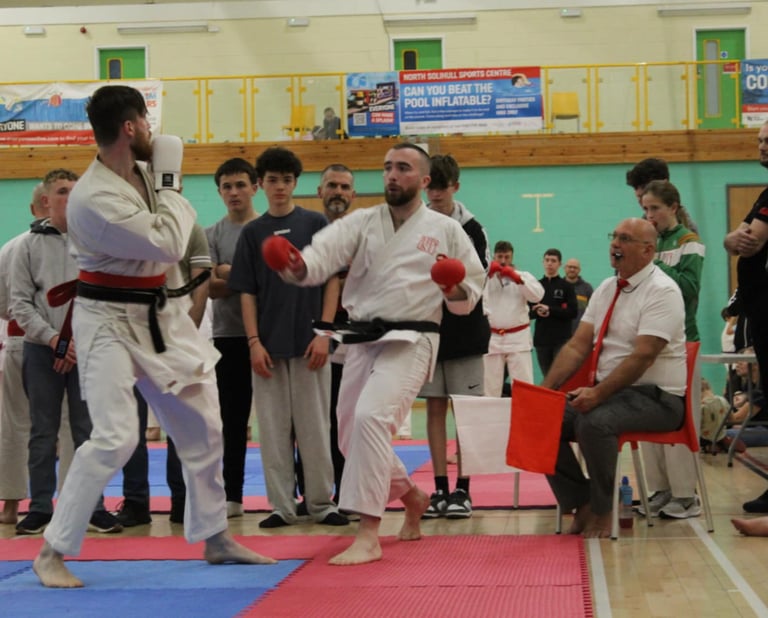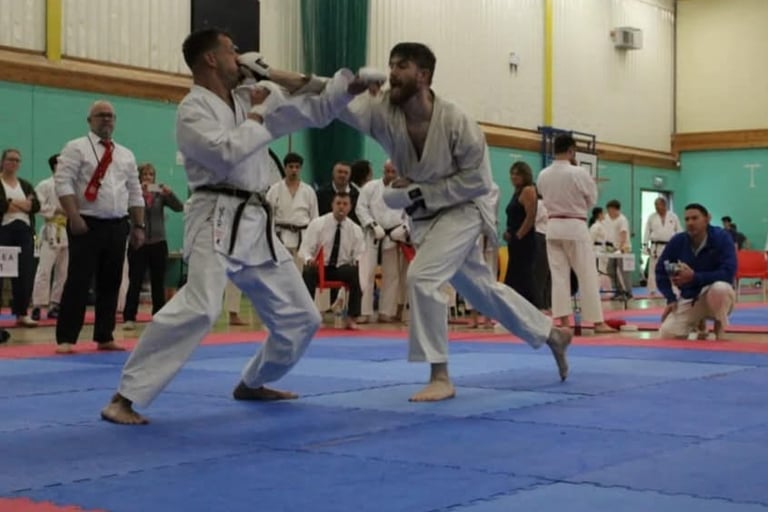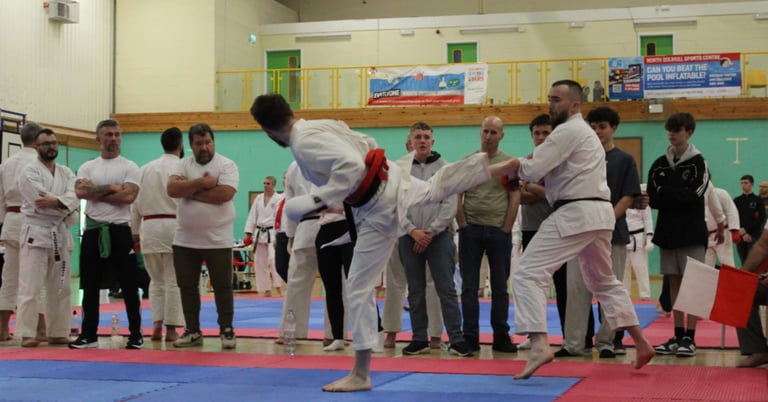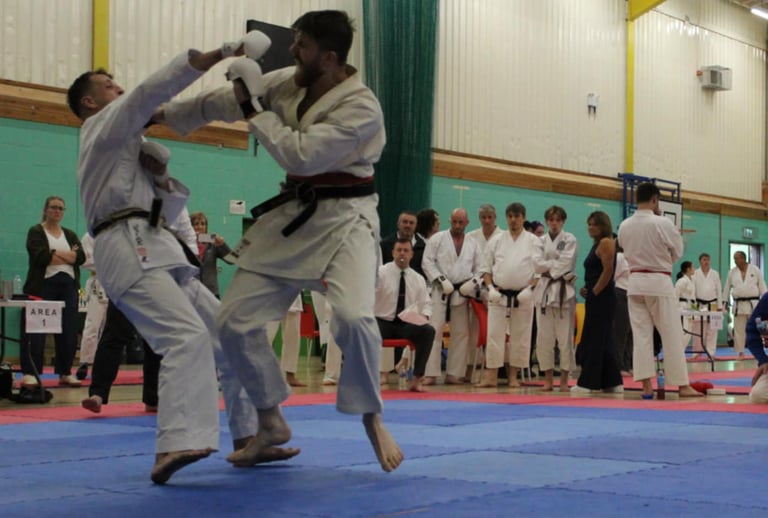Strength and Conditioning for Competitive Karateka
J Dowell
11/2/20256 min read


When preparing for competition we need to think about more than our Karate skills.
Strength and Conditioning or ‘S&C’ plays a vital role in developing your ability to perform at your best and off set as well as rehabilitate injuries picked up in training.
Read on to learn how S&C can help you get stronger, faster, fitter and more explosive, so you can perform at your best on the tatami, whether you’re stepping on to it for Kumite or Kata.
Strength
The ‘strength’ part of strength and conditioning refers to the strength of your muscles, but it relates to more than how much weight you can lift.
Strength can refer to the amount of muscle mass you have, your ability to produce force and your resistance to injury (stronger muscles are less likely to be injured).
We need to think about three factors when it comes to the ‘Strength’ part of S&C, Size, strength and power
Size= The volume of muscle you hold.
Strength= The body’s ability to generate force.
Power= The speed at which maximal force can be produced.
Strength is the result of the amount of muscle tissue you have and your body’s ability to effectively use that muscle (trained through lifting heavy weights).
This means the more muscle tissue you have, the greater potential strength you have. Resistance training develops ‘fast twitch’ muscle fibres. Unsurprisingly these muscle fibres are what will allow us to move at top speed.
The more you lift heavy weights the more you develop the ability to recruit those muscle fibres.
When our muscle fibres are first built they are not automatically recruited during resistance training. The body has to learn to use them. This is done through lifting weights.
We can think of resistance training as ‘waking up’ the muscle fibres.
Once you have built some muscle you can then focus on making it ‘powerful’. Do this using lighter weights and moving them as fast as possible.
Now we understand how muscle, strength and power interact with one another lets take a look at how to implement the necessary training into your competition preparation.
6-month block
For the purposes of this piece lets assume you have 6 months (24 weeks) until your next competition.
The first 3 months (12 weeks) can be thought of as ‘pre-training prep’. This is where we will focus on ‘increasing’ muscle size.
Building muscle requires a lot of energy and your sleep and nutrition need to be on point alongside your training, this is why it is done in our ‘off season’.
Muscle Size
Increasing muscle size would require its own discussion to fully cover its complexities.
In order to cover it in short we can say that our weight training should feature higher volume training (volume refers to the amount of work you do i.e more reps/more sets= higher volume) with the last sets of each exercise pushed close to failure (this is known as higher intensity or ‘effort’).
We also need to make sure we progressively overload our training each week (i.e either increasing volume or intensity each training session).
Strength training
This will require us to lift fewer reps at a heavier weight, compared to training for muscle size.
Aim for 1-5 reps on your compound movements (bench press, squat, deadlift), you can keep your reps high for accessory movements targeting smaller muscle groups (tricep push downs, calf raises or bicep curls for example).
Strength training requires longer rest periods to allow you to recover between lifts, with high volume maintained.
Power
Power is developed by moving against a resistance as fast as possible. You need to use a lighter weight compared to your strength training and try to move it as fast as possible.
Examples of exercises you can use to develop your power include
Explosive press ups- Throw yourself off the ground as fast as possible. This will translate into the speed of your punches, as the chest, triceps and front delts (primary movers of this exercise) all need to fire quickly when punching.
Jumping Bulgarian split squats- This movement targets the major muscles in the upper leg.
The quads, hamstrings and glutes are all activated and must quickly contract from being being fully stretched (at the bottom of the movement).
This develops the explosive movement needed to move around the tatami, evade and attack your opponent.
Calf jumps- The Bulgarian split squat focuses on the upper leg, whereas this exercise will focus on the calf.
The explosive potential of the calf will play a big role in your ability to cover ground when fighting.
Try to minimise the bend in your knee and jump into the air as high as you can. You could also do this movement as a box jump.
We are trying to focus on the calf and minimise involvement from the larger leg muscles above the knee, hence why the knee should not be bent too deeply.
When aiming to improve your power think about the body parts used during kumite and aim to train those movements with resistance training.
By spending the ‘pre-season’ (6 months out of competition, 12 weeks before we begin our real competition training) building muscular size and strength we can exponentially increase our potential power output for the competition preparation (12 weeks before the competition).
Hopefully you can see how this process can compound over time through various competition preparations.
As we repeat the cycle of building muscle, getting stronger and developing power, over the long term we can continually improve our athletic performance.
Conditioning
Conditioning is your ability to deal with the cardio-vascular demands of your sport. In other words how ‘fit’ you are.
Both Kata and Kumite are short and explosive events.
Kumite features a lot a lot of moving around, feinting and attacks are thrown at full speed which can drain your energy quickly.
Kata requires you to move at full speed from start to finish (excluding the slow movements, which still require a lot of connection within the body).
The majority of fights are 2-3 minutes long and can feature an extension of 1-2 minutes.
Fighters must be fit enough to fight for 3-4 minutes and recover in between rounds.
If you win multiple fights during the competition you will need to be able to recover in between those rounds.
The longest Kata lasts 1 to 2 minutes but 30-45 seconds is probably more realistic. But those 30 seconds need to be full blast!
You could have a gap of 3, 5, 10 or 15 minutes between fights/kata’s depending on the size of the competition.
Conditioning training should aim to recreate the short, explosive nature of the sport and help us fully recover between rounds.
Periodised fitness training
Like our Strength training our conditioning should develop over time.
When we are 6 months out, we can focus on improving our anaerobic base and work capacity, before increasing intensity and lowering volume as discussed above.
Higher volume and lower intensity training sessions include long distance runs or longer swimming sessions.
These sessions should aim to increase your heart rate and maintain that level for the duration of the run. This will help to build your aerobic capacity.
Long training sessions at a lower intensity will allow you to work on new skills without pushing yourself to the limits of your physical fitness.
Supplementing this training regime with weight training and longer distance runs can help you improve your work capacity for the more intense training sessions further down the line as we get closer to competition.
As we get nearer the competition, from around 12 weeks out, our cardio training should begin to lower in volume and increase in intensity.
Once we are within 12 weeks, long, slow cardio training should be avoided. The energy requirements for this kind of high-volume cardio training are very high, and they don’t do a good job of preparing us for the explosive nature of kumite.
Instead of running 5-6 miles at a slow pace like we might do 6 months out, we should instead run 15-20 minutes at a very high pace.
This sort of training method is designed to push the boundaries of an athlete’s physical fitness, so a high degree of effort is required for this to be effective.
Other training exercises include hill sprints, tabata training, bag work or shadow boxing.
Any form of cardio training is effective, as long as you train with high enough intensity.
Remember that you can train long or you can train hard, but you can’t do both.
As we get closer to competition (last week or two) we can do the last couple of sets of a cardio exercise with longer breaks in between them to recreate the feeling of going through the rounds of competition.
Summary
Over the long-term S&C training should act as the foundation of your training, allowing you to perform at your best on the mat.
You can think of S&C as the engine of your car, your skills, abilities and knowledge allow you to drive the car, turn corners and brake when needed. The engine provides the base power which makes the car move.
By including S&C training into your competition preparation hopefully you can develop your abilities, improve your performance and offset any injuries.





